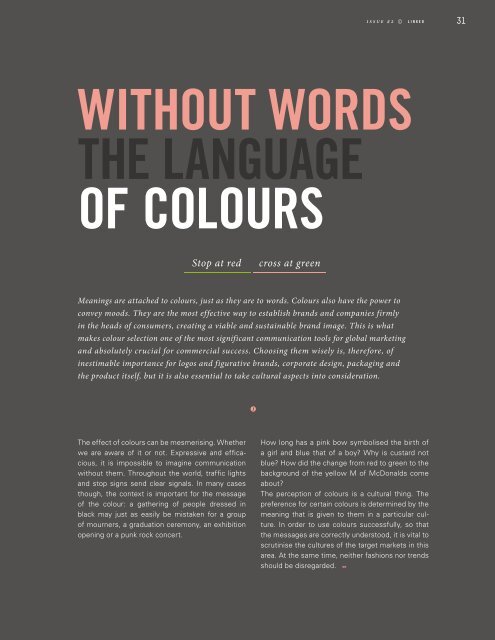Janoschka magazine_Linked_V2_2017
Create successful ePaper yourself
Turn your PDF publications into a flip-book with our unique Google optimized e-Paper software.
issue #2 © l i n k e d 31<br />
Without Words<br />
the Language<br />
of Colours<br />
Stop at red<br />
cross at green<br />
Meanings are attached to colours, just as they are to words. Colours also have the power to<br />
convey moods. They are the most effective way to establish brands and companies firmly<br />
in the heads of consumers, creating a viable and sustainable brand image. This is what<br />
makes colour selection one of the most significant communication tools for global marketing<br />
and absolutely crucial for commercial success. Choosing them wisely is, therefore, of<br />
inestimable importance for logos and figurative brands, corporate design, packaging and<br />
the product itself, but it is also essential to take cultural aspects into consideration.<br />
The effect of colours can be mesmerising. Whether<br />
we are aware of it or not. Expressive and efficacious,<br />
it is impossible to imagine communication<br />
without them. Throughout the world, traffic lights<br />
and stop signs send clear signals. In many cases<br />
though, the context is important for the message<br />
of the colour: a gathering of people dressed in<br />
black may just as easily be mistaken for a group<br />
of mourners, a graduation ceremony, an exhibition<br />
opening or a punk rock concert.<br />
How long has a pink bow symbolised the birth of<br />
a girl and blue that of a boy? Why is custard not<br />
blue? How did the change from red to green to the<br />
background of the yellow M of McDonalds come<br />
about?<br />
The perception of colours is a cultural thing. The<br />
preference for certain colours is determined by the<br />
meaning that is given to them in a particular culture.<br />
In order to use colours successfully, so that<br />
the messages are correctly understood, it is vital to<br />
scrutinise the cultures of the target markets in this<br />
area. At the same time, neither fashions nor trends<br />
should be disregarded.









